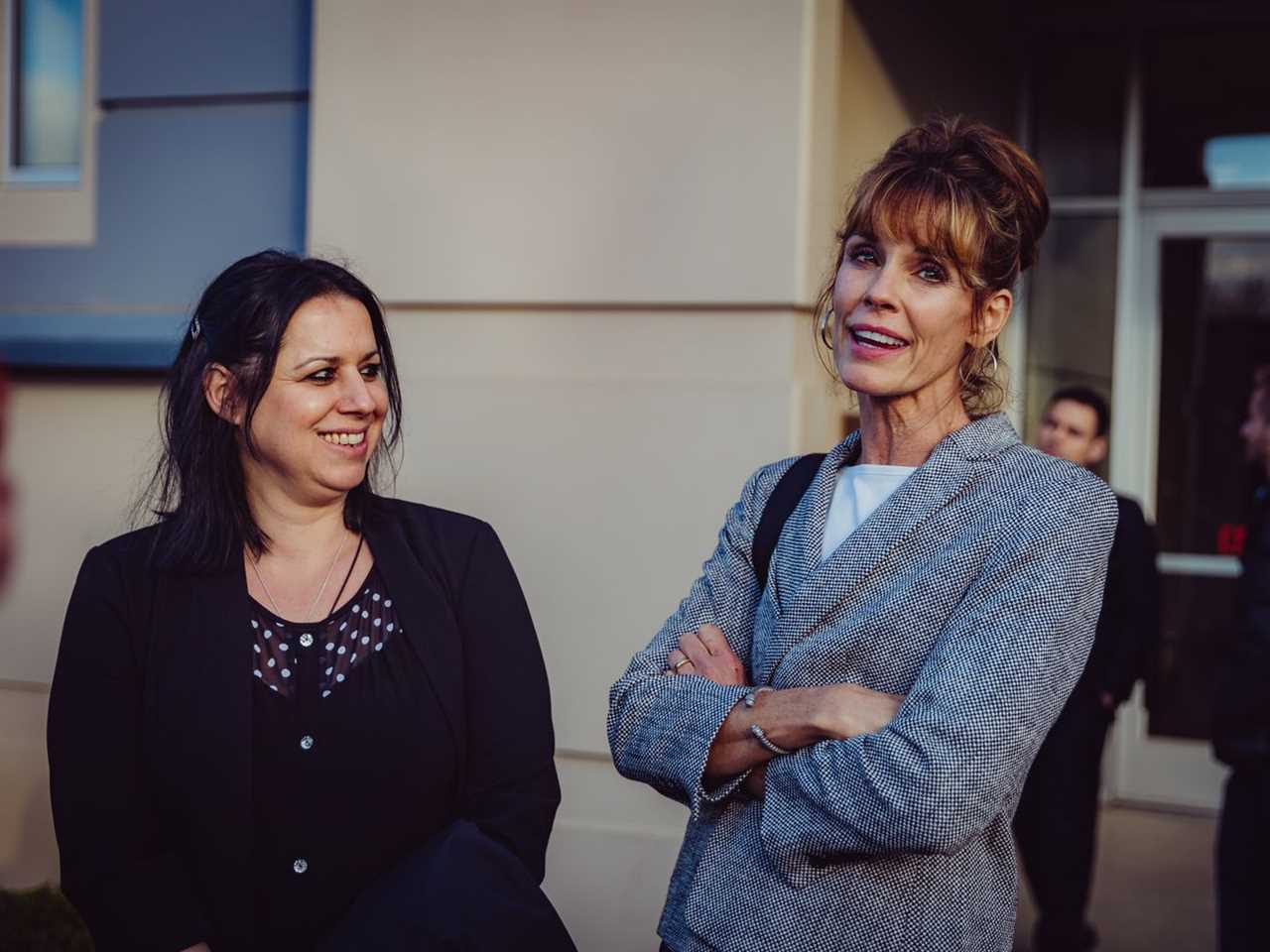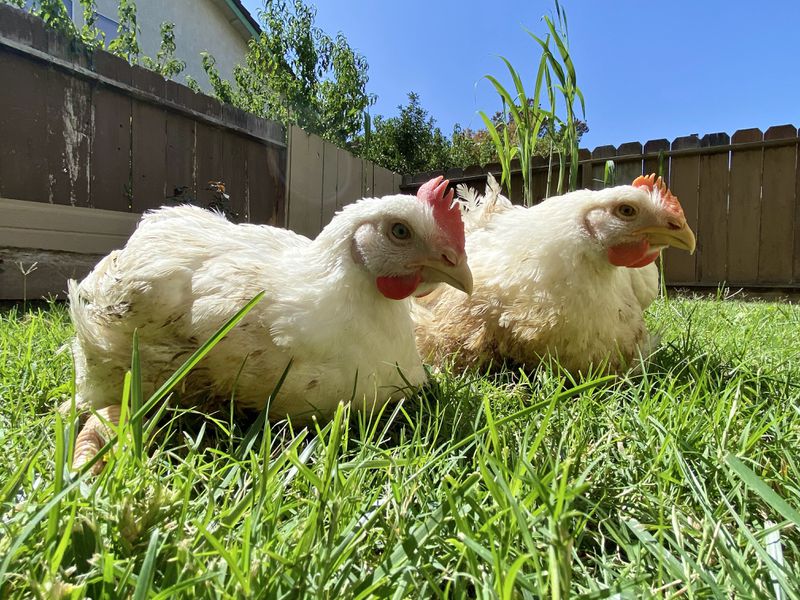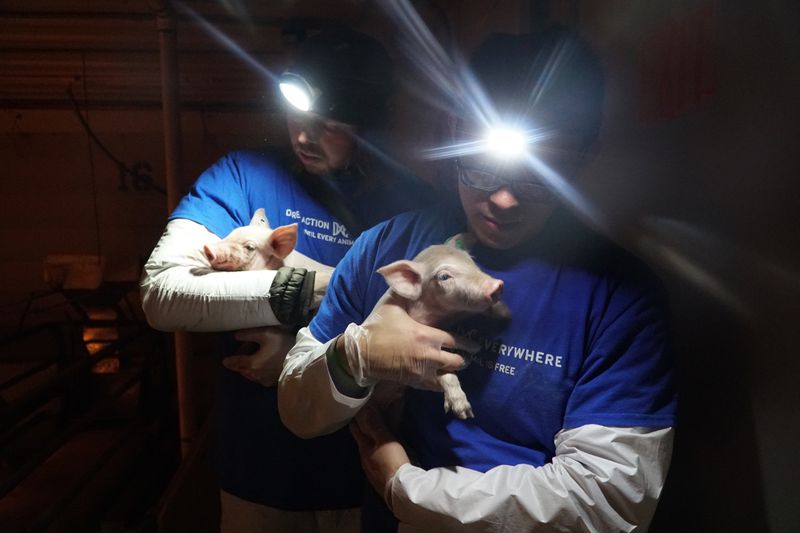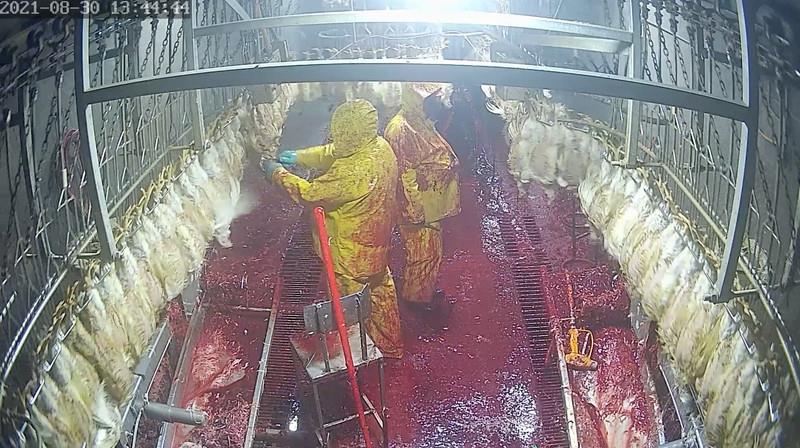
Two activists were just acquitted for taking factory-farmed chickens worth $16.
On Friday, after nearly six hours of deliberation, two animal rights activists facing misdemeanor theft charges were acquitted by a California jury. The alleged crime — which the activists freely admitted to — involved taking two sick, slaughter-bound chickens from Foster Farms, one of the biggest poultry companies in the US. Prosecutors called it stealing, but the defendants, Alicia Santurio and Alexandra Paul, both members of the animal rights group Direct Action Everywhere (DxE), called it a rescue.
Santurio and Paul (the latter a former Baywatch actress and longtime social justice activist) had taken the chickens from a truck outside a Foster Farms slaughterhouse in Livingston, California, in September 2021. According to Foster Farms, the animals were each worth $8.16, though the defendants still faced up to six months in jail if convicted. But unlike most criminal defendants, Santurio and Paul welcomed the prosecution — they refused multiple plea deals, including one that came with no jail time and would’ve eventually cleared the charge from their records.

Direct Action Everywhere
The chickens’ rescue followed a 2021 hidden-camera investigation (conducted by a separate DxE activist) at the same slaughterhouse, which drew attention to the appalling cruelty of poultry slaughter. When the birds — whom the activists named Ethan and Jax — were removed from the slaughter truck by Santurio and Paul, they were both severely ill and struggled to stand. (Many factory-farmed chickens have been bred to grow extremely big extremely fast, and by the time they reach slaughter weight at six weeks old, their legs often can’t support their weight.) Ethan died four days after the rescue, while Jax recovered after intensive veterinary care and now lives on a farm sanctuary.
The defense argued that they weren’t breaking the law because Ethan and Jax were in such terrible shape when they arrived at the slaughterhouse that they were unfit for the food supply, making them worthless to Foster Farms. Both birds had multiple illnesses, and a veterinarian testified for the defense that Ethan’s necropsy showed he had Enterococcus faecium, a multidrug-resistant bacterial infection that can infect and kill humans and which has been linked to the chicken industry.
The acquittal “is a statement in defense not just of these two women’s right to rescue animals, but the right of every living being to be protected from corporate abuse,” said Paul’s attorney, Wayne Hsiung, a co-founder of DxE who has been a defendant in two other rescue trials, outside the courthouse in Merced, California. “It should be a clarion call for animal-abusing corporations that if you are going to hurt animals, people will intervene and stop you, and they will be defended by our community and by American citizens.”
Since its founding a decade ago, DxE, a grassroots animal rights group, has been testing out this strategy, which it calls “open rescue”: activists walk into factory farms and slaughterhouses and simply remove animals suffering there, taking them to receive veterinary care and eventually to live out their lives peacefully on animal sanctuaries. The tactic serves an elegant double purpose, saving animal lives in the immediate term while intentionally provoking conflict with a legal system that treats living beings on farms as though they were inanimate property rather than sentient individuals.
Santurio and Paul’s victory comes after a historic trial last October, in which DxE activists were acquitted by a Utah jury after facing a decade in prison for rescuing two sick, dying piglets said to be worth $42 each from Smithfield Foods, America’s top pork producer. More and more of the group’s rescues are making their way to trial (two more cases are scheduled for this year), where activists often facing lengthy prison sentences attempt to convince juries that they have a “right to rescue.”

Direct Action Everywhere
As a long-time reporter on factory farming and the animal movement, I’ve been obsessively covering these cases for more than a year, and until very recently, I thought winning them was near-impossible. I was wrong. Now — with progress for animals seemingly at an impasse as meat consumption continues to grow, plant-based meat remains a niche product, and the meat industry fights hard-won bans on its worst practices — I increasingly think these tactics are vital to the long fight to end factory farming in the US.
The theory behind open rescue
I’m almost congenitally pessimistic about our chances of making life better for nonhuman animals, because so little has worked so far. The number of animals slaughtered for food every year is enormous and rising, in the US and the world. Compared to the rapidly worsening situation for animals, the gains made by the animal movement feel vanishingly small. Animal welfare groups have, for example, convinced many corporations to raise egg-laying hens free from cages — an impressive achievement that took immense effort, but it’s such a small improvement over the status quo that I’m hesitant to call it a victory. We need, at the very least, to experiment with novel strategies alongside marginal welfare improvements in the meat industry.
What I like about open rescue, and the philosophy of direct action more broadly, is that it’s utopian: it enacts the ultimate outcome that activists want to achieve for farmed animals, which is freedom from exploitation and commodification. Direct action represents “the defiant insistence on acting as if one is already free,” as the late anthropologist David Graeber put it (in a context very different from animal liberation). It’s about “creating a vision of the sort of society you want to have in miniature.”
By doing this, activists are refuting animals’ status as chattel, albeit indirectly. Animals’ property status makes it exceedingly hard to fight directly on their behalf in court, as seen in the unsuccessful recent lawsuit that attempted to establish personhood for Happy the elephant and free her from the Bronx Zoo.
If animals can’t stand in court, human activists can put their freedom on the line for them instead. “Because animals still don’t have legal standing, this is, in a roundabout way, the only way we can get their issues spoken about in a courtroom,” Jeremy Beckham, a former executive director of the Utah Animal Rights Coalition and an aide to DxE’s legal team for the Smithfield trial, told me via text. “Rescuers can advocate on their behalf in a public trial, and through the remarkable risk they take upon themselves, demonstrate the strength of their convictions and the urgency of the issue.”
A trial offers a chance for rescuers to tell the stories of the animals they saved, connecting the fathomless billions suffering in factory farming to individual animals with lives worth living. Santurio and Paul testified at their trial last week about Foster Farms not being held accountable for how it treats its animals, describing DxE’s investigation at the slaughterhouse where Ethan and Jax would have imminently been killed. The footage shows birds thrown to the concrete floor and left to die, piling up on top of one another. One discarded chicken has their head stuck under a fence and struggles to escape. Some birds jump from the conveyor belt to the floor and are thrown back against the slaughter shackles. They’re then hung and dragged through an electric bath meant to stun them, but some lift their heads above the water and are never stunned properly, so their necks are sliced while still conscious. Workers are visibly overwhelmed as the slaughter line moves extremely fast; according to a 2021 Foster Farms training manual obtained by DxE, they’re each expected to shackle 23.3 chickens per minute.
These revelations are consistent with a 2015 investigation into Foster Farms by the animal welfare group Mercy For Animals, which also found birds being scalded alive in boiling water at the defeathering stage, after missing the blade meant to slaughter them. (This has also been documented in federal inspection reports at Foster Farms). Responding to questions about these allegations, Ira Brill, the company’s vice president of communications, said in an email, “Foster Farms has no comment.” (Before the trial, a Foster Farms spokesperson told the New York Times that allegations of inhumane treatment “are without merit and a disservice to the thousands of Foster Farms team members that are dedicated to providing millions of families in the Western United States and beyond with a quality nutritious product.”)

Direct Action Everywhere
“It doesn’t matter where I go, what year I go — I’m always going to find horrific animal cruelty and neglect at Foster Farms,” Santurio testified last week, saying that she’s been inside five different Foster Farms facilities and sent legal complaints about the conditions to law enforcement. “We contacted animal control, the sheriff, the DA, the attorney general,” she told me in an interview. “No response.”
In light of this history, Paul told the jury, her motives were simple: “You feel like, who is going to do something, if not I? If not us?”
Direct rescue has proven it can work — and use of the tactic is growing
In late 2021, I was getting ready to cover the trial of Matt Johnson, another DxE activist who was facing prosecution in Iowa over a piglet rescue and an undercover investigation at Iowa Select Farms, the state’s largest pork producer. (His trial ultimately never happened; the charges were dropped at the very last minute.) I asked Justin Marceau, a professor who specializes in animal law at the University of Denver’s Sturm College of Law, what implications it could have for animal rights if Johnson won his case.
His answer was clarifying: on one level, a victory wouldn’t necessarily mean anything because jury trials have no legal precedential value. One jury’s decision has no bearing on how another jury rules in a similar case. On another level, he said, an activist victory would mean everything, because prosecutors hate to lose trials and aim to pursue cases that they think they’ll win. If they sense hesitation among jurors to convict animal activists, they won’t want to pursue them anymore, which in turn creates new opportunities for activists to carry out more ambitious rescues. If activists lose a case, they can challenge it at the appellate level, where decisions do have precedential value. For example, defendants could appeal a judge’s decision to not allow them to show certain kinds of evidence (like conditions inside a factory farm) or use certain kinds of defenses, and an appeals court ruling then creates binding precedent that will influence what happens in future trials.
When I first talked to Marceau a year and a half ago, these seemed like remote, highly aspirational outcomes. Then DxE won the Smithfield trial in Utah, and the canvas for animal advocacy suddenly expanded. DxE’s theory — that when you show a jury of ordinary citizens what happens to animals in the meat industry, they’ll agree that they deserve rescue — turned out to be true, challenging the idea that the animal rights agenda is radical or unpopular.
The open rescue strategy is now gaining attention from legal experts — a notable change from the last decade-plus, when animal advocates shied away from such risky tactics, shaken by high-profile criminal convictions of activists in the 2000s. Last fall, the University of Denver started the Animal Activist Legal Defense Project, a law clinic devoted to representing activists facing prosecution; one of its attorneys, Chris Carraway, represented Alicia Santurio in the Foster Farms trial last week. At the project’s launch in October, Marceau spoke about the remarkable legal achievement of the Smithfield trial. It showed for the first time that sometimes it can be legal to take animals from factory farms without the consent of their owners, opening up radically different possibilities for animal law, he said. (Disclosure: University of Denver’s animal law program, where Marceau is faculty director, gave me a journalism award at this event.)
There were, to be sure, important limits to that victory. The verdict depended in large part on DxE being able to prove that the two piglets it rescued were so ill that they wouldn’t have survived much longer in Smithfield’s care, thereby making them worthless to the company in monetary terms. That was crucial to the acquittal because to meet the threshold for theft, the alleged stolen property needs to have value.
A similar argument was central to the recent California trial. Many factory farms throw away sick animals who won’t make it to slaughter weight, which is an industry vulnerability activists can exploit in open rescue trials. But the flipside is that this ties whether or not an animal can be legally rescued to whether they can make money for the meat industry. A key challenge in future litigation will be to devise legal arguments that truly transcend animals’ property status.
Open rescue cases put factory farming on trial
One way of doing that is to try to introduce a “necessity defense,” in which a criminal defendant argues their actions were necessary to prevent a greater harm, like smashing a window in a locked car to save an overheated dog inside. The judge in the Utah Smithfield trial didn’t allow the defendants to use a necessity defense, nor did the judge in last week’s trial, Merced Superior Court Judge Paul Lo, who said that such a defense could only be used to save humans.
But whatever limitations are put on defendants in rescue cases — and especially in the Utah trial, activists’ ability to show the jury factory farm conditions was greatly limited — their message has, so far, come through. Watching the Merced trial last week, I was moved to see the lives of animals that society treats as disposable deliberated at length in a courtroom. Santurio and Paul appeared knowledgeable, convincing, and morally credible to my eyes. Veterinary and animal care experts testified on the deplorable conditions chickens are raised in. A Foster Farms executive was questioned about what the company does with animals who arrive at the slaughterhouse too sick to enter the food supply. A police officer said that allegations of animals scalded alive would be an important issue for his office to investigate. By the closing arguments, prosecutor Travis Colby was forced to concede that “the chicken business may not be a pleasant business.”
Judge Lo, at the end of the trial, told jurors that “this is not just about two chickens. It’s about very important principles.” This is, of course, why the factory farm industry sought to punish two activists for taking property valued at less than $20. As activists bring more cases, the risk of harsh industry, law enforcement, and political backlash increases. The FBI, which has historically categorized animal and environmental activists as terrorists, has already investigated DxE for multiple incidents and played a significant role in the Smithfield trial. In Utah, legislators swiftly passed an “anti-rescue” law after the Smithfield trial to prevent activists from using the same defense that helped DxE win.
But that everyday citizens are siding with DxE (some jurors have even spoken about how revelatory the experience was for them) is evidence enough that these fights are worthwhile — and they’ve made me more optimistic than I’ve ever been about the animal movement’s future.
----------------------------------------
By: Marina Bolotnikova
Title: The fight against factory farming is winning criminal trials
Sourced From: www.vox.com/future-perfect/23647682/factory-farming-dxe-criminal-trial-rescue
Published Date: Tue, 21 Mar 2023 11:30:00 +0000






